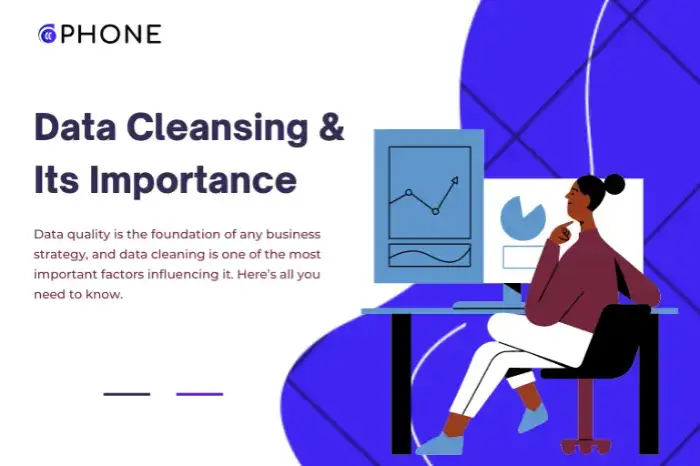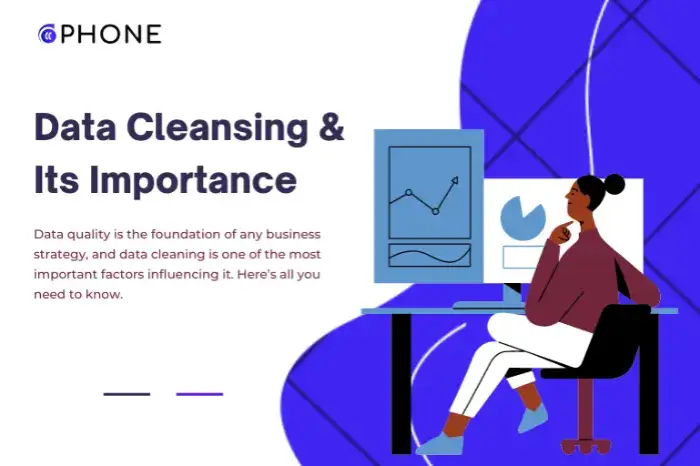What is Data Cleansing & Its Importance?

Data quality is crucial for any business in the 21st century. Quality data underpins better decisions, analytics, campaign management, customer experience, and reporting, so get it right and improve your efficiency and reputation for years to come.
However, all data stored over time is bound to get corrupted. And if you are working with poor-quality data, you are surely going to be stuck between bad decisions and outcomes.
Therefore, to maintain good data quality and a healthy database, it is imperative to invest in data cleansing.
So, in this blog, we are going to decode everything related to data cleansing. Let’s dive in!
What is Data Cleansing?
Quite simply, data cleansing involves a review of all the data within a database to either remove or update information that is incomplete, incorrect, improperly formatted, duplicated, or irrelevant. According to Forbes, about 27% of business leaders aren’t sure how much of their data is accurate, making data cleansing a worthwhile activity for most organizations.
The objective of data cleansing is to fix any data that is incorrect, inaccurate, incomplete, incorrectly formatted, duplicated, or even irrelevant to the objective of the data set.
This is typically accomplished by replacing, modifying, or even deleting any data that falls into one of these categories.
Why data cleansing is important for every business?
Data cleansing is a business-critical part of data management. Over time, businesses accumulate a lot of information about their customers and prospects. Information can become outdated quite quickly, from the basics of contact names and addresses to financial details and product portfolios.
1. Avoid errors leading to cost and credibility loss.
Organizations believe that nearly 30% of their data is incorrect on average. Companies lose 12% of their total revenue as a result of dirty data — and they're losing more than just money. Cleansing generates consistent, structured, and accurate data, allowing for informed and intelligent decisions.
It also identifies areas for improvement in upstream data entry and storage environments, allowing you to save time and money now and in the future.
2. For targeting the right audience and customer retention.
When data becomes coarse, businesses begin to target the wrong market. Customer habits are changing so quickly these days that data can quickly become out of date. The sheer volume will eventually strain the system, so it must be cleaned up. Data cleansing will purge this outdated information in favor of new, up-to-date information about your target market.
Clearout’s solutions help to mitigate the problem by automating the process of cleansing your data and ensuring you are reaching out to the right customers.
👉 Learn more about our solutions – Clearout & ClearoutPhone
3. Boosts efficiency and productivity.
Cluttered databases reduce productivity. It takes more time to retrieve information from a database overloaded with outdated incorrect data. Not only is it hard for your team to use the data but it can lead to potential delays in workflow. For example, you keep reaching out to the wrong leads, or contractors no longer associated with your business.
On the contrary, when incorrect data is removed or updated, organizations are left with high-quality information, which means your teams are not wasting time wading through irrelevant and incorrect data.
4. Make better use of data
Data cleansing paves the way for successful multichannel customer data management.
Accuracy in customer data, including phone, postal, and email channels, enable your contact strategies to be executed successfully across channels.
5. Improves ROI
Effective processes are critical in business. Spending a significant amount of time cleaning data can be very costly.
Businesses that work to improve the quality of their data through an effective data-cleansing strategy can significantly increase their customer response rates. As a result, there is increased productivity, happier customers, and much better decisions.

How to carry out data cleansing?
1. Fill in the missing data
Filling in any missing values is a critical component of quality data management. For example, Missing postcodes may result in undelivered goods, while missing surnames may result in important communication being misdirected.
Or, when you are running an SMS campaign for product promotion or update, but miss out on the carrier details or country code which is External parties are frequently used to add missing elements to create a complete dataset.
2. Validating existing data
Reviewing existing data for consistency and accuracy will have far-reaching benefits from maintaining your communication channels to ensuring that you will be able to fulfill any legal obligations.
With – Clearout & ClearoutPhone you can easily deal with validating the email addresses and phone numbers in your database and take necessary action on outdated/ invalid data.
3. Removing duplicate data
Data quality is jeopardized by duplicate records. These errors typically occur during the collection process. Duplicate records will be a much bigger problem if the data is entered and maintained manually. Because management only has incorrect statistics, duplicate data leads to poor decisions.
Hence, the identification and removal of duplicate records become mandatory to keep your database ship-shape and accurate.

4. Handling structural errors
Structural and syntactical errors are another major problem that downgrades the quality of your database. Redressing such mistakes that arise from processing such as measurement and transfer of data illustrates the importance of data cleansing.
Inconsistent punctuation, typos, and mislabelled classes are the most common problems that must be resolved. If you are dealing with email addresses it can be a missed character, or in case of phone numbers, mistyped country codes, and so on…
Luckily Clearout helps you deal with such problems in a quick and efficient way with auto-suggestions.
How often should you carry out data cleansing?
The data cleansing process is usually completed all at once and can take a long time if the information has been accumulating for years. That is why data cleansing should be done on a regular basis.
The frequency with which organizations should cleanse is determined by several factors, including the volume of data they hold. It's also important not to clean too frequently, or you'll waste resources by doing things that aren't necessary.
Final Words…
To offer a superior customer experience, gain a competitive advantage, and move your business forward, quality data is the glue that binds these processes together.
In this time of flux and change, the – Clearout & ClearoutPhone team is here to help you build lasting customer relationships by validating, updating, and maintaining good-quality data.
Search
Recent Posts
- 15 Ready-to-Use SMS Templates That Actually Convert in 2026 December 11, 2025
- Boost SMS Marketing with Carrier & Line-Type Segmentation November 27, 2025
- 7 Proven Ways to Reduce SMS Marketing Costs and Boost ROI October 23, 2025
- 5 Best SMS Marketing Platforms in 2025 (Our Top Picks) August 28, 2025
- How to Send Bulk SMS in 2025: Step-by-Step Guide That Works August 18, 2025
Phone Validation Service
Reach out to more real customers for your business
Create a free account with 100 credits

